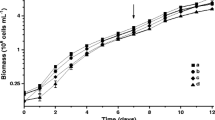Summary
Poly-L-lysine concentrations (10−6 m) which cause slight leakage of pigment from beet cells completely disrupt the kinetics of*K (labeled) absorption at 25°C in the range 0.01 to 50mm KCl. Lower concentrations of polylysine (10−7 to 10−9 m) interfere with potassium fluxes at both cell membranes, initially increasing efflux across the plasma membrane and decreasing the capacity of the cytoplasm to retain ions during flux experiments at 2°C. At 25°C, these concentrations of polylysine increase*K (labeled) absorption from 0.2mm KCl, but not from 10mm KCl. These responses are discussed in relation to ion transport via the three-compartment in-series model proposed for plant cells. Particular emphasis is placed on the role of the plasma membrane in K transport from solutions of low concentration.
Similar content being viewed by others
References
Buchanan-Davidson, D., Deese, D., Uritani, J., Stahman, M. 1960. Effect of synthetic polylysine on fungi.Science 132:1664.
Burger, W., Stahman, M. 1952. The agglutination and growth inhibition of bacteria by lysine polypeptides.Arch. Biochem. Biophys. 39:27.
Cram, W. J. 1968. Compartmentation and exchange of chloride in carrot root tissue.Biochim. Biophys. Acta 163:339.
Dilley, R. A. 1968. Effect of poly-L-lysine on energy-linked chloroplast reactions.Biochemistry 7:338.
Epstein, E. 1966. Dual pattern of ion absorption by plant cells and by plants.Nature 212:1324.
— Hagen, C. E. 1952. A kinetic study of the absorption of alkali cations by barley roots.Plant Physiol. 27:457.
Johnson, C. L., Mauritzen, C. M., Starbuck, W. C., Schwartz, A. 1967. Histones and mitochondrial ion transport.Biochemistry 6:1121.
Laties, G. G. 1969. Dual mechanisms of salt uptake in relation to compartmentation and long distance transport.Ann. Rev. Plant Physiol. 20:89.
— MacDonald, I. R., Dainty, J. 1964. Influence of the counter ion on the absorption isotherm for chloride at low temperature.Plant Physiol. 39:254.
Lüttge, U., Bauer, K. 1968. Evaluation of ion uptake isotherms and analysis of individual ion fluxes.Planta 80:52.
MacRobbie, E. A. C. 1969. Ion fluxes to the vacuole ofNitella translucens.J. Exp. Bot. 20:236.
Osmond, C. B., Laties, G. G. 1968. Interpretation of the dual isotherm for ion absorption in red beet tissue.Plant Physiol. 43:747.
Pallaghy, C. K., Scott, B. I. H. 1969. The electrochemical state of cells of broad bean roots. II. Potassium kinetics in excised root tissue.Aust. J. Biol. Sci. 22:585.
Pitman, M. G. 1963. The determination of the salt relations of the cytoplasmic phase in cells of beetroot tissue.Aust. J. Biol. Sci. 16:647.
Schwartz, A. 1965. The effect of histones and other polycations on cellular energetics. I. Mitochondrial oxidative phosphorylation.J. Biol. Chem. 240:939.
Siegal, S. M., Daly, O. 1966. Regulation of betacyanin efflux from beet root by poly-L-lysine, Ca-ion and other substances.Plant Physiol. 41:1429.
Author information
Authors and Affiliations
Rights and permissions
About this article
Cite this article
Osmond, C.B., Laties, G.G. Effect of poly-L-lysine on potassium fluxes in red beet tissue. J. Membrain Biol. 2, 85–94 (1970). https://doi.org/10.1007/BF01869852
Received:
Issue Date:
DOI: https://doi.org/10.1007/BF01869852




